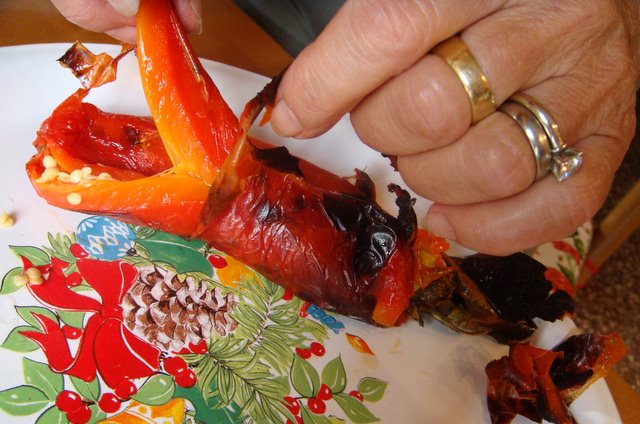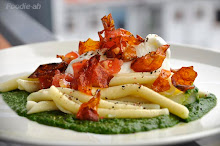If you are up for something more special and adequate for a gurmet palate, I would like to recommend this restaurant which I had the pleasure of visiting during my last trip to Bologna. Ristorante Burani is not located in the city centre, and you need a car to get to the place. The location is Pieve di Cento, about 40 minutes drive from the city centre.
This restaurant has been awarded "1 fork" (on a scale of 1 to 3) by "gambero rosso", which is a very significant award within the Italian culinary scene.
 As in any respectable Italian restaurant, you will be served a selection of bread specially prepared by the chef. The bread was of good quality, although not absolutely the best.
As in any respectable Italian restaurant, you will be served a selection of bread specially prepared by the chef. The bread was of good quality, although not absolutely the best. This 'zuppa di carciofi con crostini' (artichokes soup with crostini) was served for 'free'. Although I am not a big fan of artichokes, I could enjoy this thick soup because of its mild flavour. The bits of crunchy bread could either be enjoyed with their crispness or soaked into the soup.
This 'zuppa di carciofi con crostini' (artichokes soup with crostini) was served for 'free'. Although I am not a big fan of artichokes, I could enjoy this thick soup because of its mild flavour. The bits of crunchy bread could either be enjoyed with their crispness or soaked into the soup. The 'flan di polenta in zuppetta di squacquerone con porcini arrostiti' was a slightly experimental version of a very traditional combination. The polenta was a lighter and fluffier version of the real thing (a pudding made from cornflour). Squacquerone is a typical local fresh cheese, which was filtered into a thick soup to create an appetizing base for the polenta.
The 'flan di polenta in zuppetta di squacquerone con porcini arrostiti' was a slightly experimental version of a very traditional combination. The polenta was a lighter and fluffier version of the real thing (a pudding made from cornflour). Squacquerone is a typical local fresh cheese, which was filtered into a thick soup to create an appetizing base for the polenta. As a starter, I ordered the 'Insalata di mare tiepida con verza e profumo d'arancia' (tepid seafood salad with cabbage and orange scent) which was better than I anticipated. The delicate flavour of a tepid melange of seafood was enhanced by underlying leaves of savoury cabbage. A lot of attention was put in the way the cabbage was seasoned, most likely with some fish/seafood stock. A well balanced orange zest tang added a kick to an otherwise fairly standard dish.
As a starter, I ordered the 'Insalata di mare tiepida con verza e profumo d'arancia' (tepid seafood salad with cabbage and orange scent) which was better than I anticipated. The delicate flavour of a tepid melange of seafood was enhanced by underlying leaves of savoury cabbage. A lot of attention was put in the way the cabbage was seasoned, most likely with some fish/seafood stock. A well balanced orange zest tang added a kick to an otherwise fairly standard dish. As a first course, my friend ordered the 'tortelli di ricotta e scalogni con castagne e fonduta di pecorino' (tortelli with ricotta and spring onions with chestnuts and melted pecorino cheese). Unfortunately these disappeared from his plate so quickly that I didn't get a chance to taste them. I won't be able to provide a detailed description, but he looked very pleased with them.
As a first course, my friend ordered the 'tortelli di ricotta e scalogni con castagne e fonduta di pecorino' (tortelli with ricotta and spring onions with chestnuts and melted pecorino cheese). Unfortunately these disappeared from his plate so quickly that I didn't get a chance to taste them. I won't be able to provide a detailed description, but he looked very pleased with them. I had the 'spaghetti freschi ai ricci di mare con broccoli, schiuma d'aglio e peperoncino' (homemade spaghetti with sea urchins and broccoli, garlic foam and chilly). Needless to say, this was the highlight for me as I always tend to prefer pasta and I love sea urchins. I enjoyed the irregular texture of these handmade spaghetti, which enabled them to absorb the 'sea flavour' released by the sea urchin roe.
I had the 'spaghetti freschi ai ricci di mare con broccoli, schiuma d'aglio e peperoncino' (homemade spaghetti with sea urchins and broccoli, garlic foam and chilly). Needless to say, this was the highlight for me as I always tend to prefer pasta and I love sea urchins. I enjoyed the irregular texture of these handmade spaghetti, which enabled them to absorb the 'sea flavour' released by the sea urchin roe. The 'spiedo di calamari e scampi gratinati al rosmarino con zuppa tiepida di fagioli' (squid and scampi skewer with rosemary gratin and tepid bean soup) was grotesquely presented, but I interpreted it as a touch of humour from the chef. Extremely soft scampi and squid were covered by a rosemary flavoured crunchy breadcrumb layer. Crusty bits of bread with beans are a very typical Italian 'home cooking' combination, but not usually presented with seafood.
The 'spiedo di calamari e scampi gratinati al rosmarino con zuppa tiepida di fagioli' (squid and scampi skewer with rosemary gratin and tepid bean soup) was grotesquely presented, but I interpreted it as a touch of humour from the chef. Extremely soft scampi and squid were covered by a rosemary flavoured crunchy breadcrumb layer. Crusty bits of bread with beans are a very typical Italian 'home cooking' combination, but not usually presented with seafood. The 'filetto di ricciola scottata con zucca al sale affumicato e olio ai crostacei' (amber jack fillet with pumpkin seasoned with smoked salt and crustacean flavoured oil) was a nice creation, fresh and well cooked. I wasn't incredibly excited by this dish as it wasn't particularly innovative except for the pumpkin mash, the sweetness of which wasn't the best match with the ddelicate flavour of the fish fillet.
The 'filetto di ricciola scottata con zucca al sale affumicato e olio ai crostacei' (amber jack fillet with pumpkin seasoned with smoked salt and crustacean flavoured oil) was a nice creation, fresh and well cooked. I wasn't incredibly excited by this dish as it wasn't particularly innovative except for the pumpkin mash, the sweetness of which wasn't the best match with the ddelicate flavour of the fish fillet. This 'zabaglione al mascarpone' was on the house to close the meal. A very small portion (but you wouldn't want it any larger) of egg yolks and mascarpone topped by a few bits of meringue hiding a pool of chocolate sauce. This is the perfect dessert for those who feel too full after a full meal and yet wish to close it with a sweet bite.
This 'zabaglione al mascarpone' was on the house to close the meal. A very small portion (but you wouldn't want it any larger) of egg yolks and mascarpone topped by a few bits of meringue hiding a pool of chocolate sauce. This is the perfect dessert for those who feel too full after a full meal and yet wish to close it with a sweet bite. The 'coconut cake with banana and lime sorbet' was a great finale. In particular I liked the crispy and bitter layer of caramelized chocolate and coffee, which balances the sweetness of this rich dessert.
The 'coconut cake with banana and lime sorbet' was a great finale. In particular I liked the crispy and bitter layer of caramelized chocolate and coffee, which balances the sweetness of this rich dessert.




















 Pizza Metro has quite a history. It was actually the very first restaurant in London that made pizza using a real wood-fired oven. At the time, it was rather hard to obtain a license allowing a wood fired oven at any restaurant's premises. On top of that, while all other London restaurants only made your standard average pizza, Pizza Metro was the first to offer real Neapolitan pizza. So many years later, Pizza Metro still offers the best pizza in London.
Pizza Metro has quite a history. It was actually the very first restaurant in London that made pizza using a real wood-fired oven. At the time, it was rather hard to obtain a license allowing a wood fired oven at any restaurant's premises. On top of that, while all other London restaurants only made your standard average pizza, Pizza Metro was the first to offer real Neapolitan pizza. So many years later, Pizza Metro still offers the best pizza in London.


 We started with a Mozzarella di Bufala with cherry tomatoes. These are flown in directly from Campania a few times per week. It was as firm and juicy as it should be.
We started with a Mozzarella di Bufala with cherry tomatoes. These are flown in directly from Campania a few times per week. It was as firm and juicy as it should be. We then had an unmissable 'Melanzane alla parmigiana' Neapolitan style. For those who never had this dish, it is a sort of 'lasagne' with no meat and no dough. Layers of fried aubergines are interleaved with layers of tomato and mozzarella, finally topped with Parmesan cheeese and baked in the oven. Any tomato lover will appreciate this dish.
We then had an unmissable 'Melanzane alla parmigiana' Neapolitan style. For those who never had this dish, it is a sort of 'lasagne' with no meat and no dough. Layers of fried aubergines are interleaved with layers of tomato and mozzarella, finally topped with Parmesan cheeese and baked in the oven. Any tomato lover will appreciate this dish.


 Cipriani London is 'the place to be'. Regularly frequented by celebrities (for instance, the night I was there, Stevie Wonder was sitting at the next table), it is a place of luxury and opulence where the food served is as simple as it can be.
Cipriani London is 'the place to be'. Regularly frequented by celebrities (for instance, the night I was there, Stevie Wonder was sitting at the next table), it is a place of luxury and opulence where the food served is as simple as it can be.















